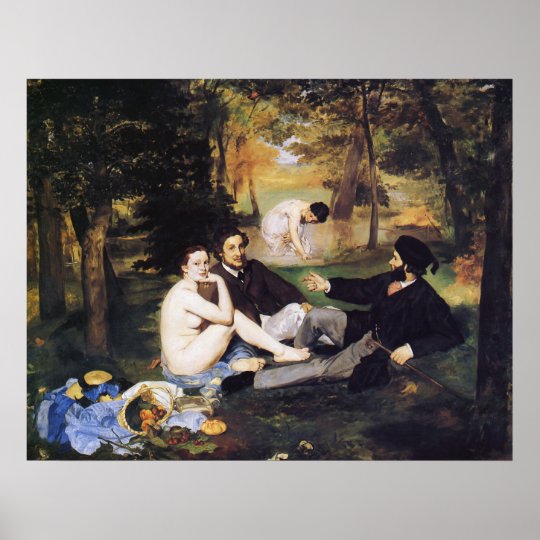
This proved to be too confrontational and unacceptable to the Parisian public when viewed at the 1865 Salon. Manet claimed to see the truth in her face, while painting her entire body for the world to see. More controversies continued in the following year when he produced Olympia (1863), which featured another nude of his favorite model, Victorine Meurent. The result was the creation of an unwitting revolutionary, and, arguably, the first modern artist. Firm in his upper-middle-class background, Manet was embedded with certain ideals of achievement and he wished to be successful at the Salon - only on his terms, not theirs. the Salon and École des Beaux Arts - operated, but he did not want them eliminated. His rebellious instincts encouraged him to want to change the system of exclusion under which the institutions - i.e. Critiques included comments that the painting was "vulgar," "immodest," and "unartistic," comments that deeply distressed Manet and likely caused him a serious bout with depression.īeing included in the Salon des Refusés would have been upsetting for Manet's ego and personal reputation.

The Renaissance allusions did not make sense to viewers, but what they did understand was the shameless and realistically rendered nudity of a woman - likely a prostitute - staring at them from the canvas. The shocking Le Dejeuner sur l'Herbe (1863) drew the most criticism for a number of reasons. Manet and others protested and the Emperor relented by putting all of the rejected works into the secondary Salon des Refusés, so the public could see what had been deemed unworthy. Manet was the focus of several of these controversies and the Salon of 1863 refused his paintings. This was a tumultuous artistic shift that pitted the status quo of the Salon with avant-garde artists who suffered mightily at the hands of the conservative public and vicious critics. He met Edgar Degas and Henri Fantin-Latour - both would become important lifelong friendships.įriends with poet Charles Baudelaire and artist Gustave Courbet, Manet moved amongst other progressive thinkers who believed that art should represent modern life, not history or mythology. His financial security also enabled him to travel through Holland, Germany, and Austria, and to visit Italy on several occasions. Becoming a flâneur of Parisian life and translating his observations onto his canvases came naturally for Manet. His ability to set up his own space (although it was a joint endeavor with painter Albert de Balleroy) was entirely due to his financial security, which also enabled him to live his life and create art in his signature fashion.

He trained under Couture for six years, finally leaving in 1856 and starting his own studio in the rue Lavoisier. While Couture was an academic painter, and a product of the Salon system, he encouraged his students to explore their own artistic expression, rather than directly adhere to the aesthetic demands of the days.

In January 1850, true to his contrary nature, instead of going to the École des Beaux-Arts to learn what he considered outdated modes, Manet joined Thomas Couture's studio. Reluctantly, his father allowed Manet to pursue his artistic goals. The following year, Manet traveled to Italy, both for the art and for social distraction. This affair resulted in a boy born in 1852, Leon, who was passed off to Suzanne's family and, to avoid scandal (from Manet's aristocratic family), was introduced to society as Suzanne's younger brother and Manet's godson. In 1849, Manet had an affair with his family's piano teacher, Suzanne Leenhoff. Today, critics see this quality as the first example of "flatness" in modern art.

In the artist's day, this flatness may have suggested popular posters or the artifice of painting - as opposed to its realism. His loose handling of paint, and his schematic rendering of volumes, led to areas of "flatness" in his pictures.The approach came to be used widely by the Impressionists, who found it perfectly suited to the pressures of capturing effects of light and atmosphere whilst painting outdoors. Rather than build up colors in layers, Manet would immediately lay down the hue that most closely matched the final effect he sought. He is credited with popularizing the technique of alla prima painting.This was also undoubtedly the root cause of many of the scandals he provoked. He did so with an acute sensitivity to historical tradition and contemporary reality. Manet's modernity lies above all in his eagerness to update older genres of painting by injecting new content or by altering the conventional elements.


 0 kommentar(er)
0 kommentar(er)
